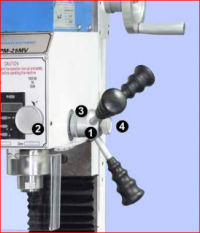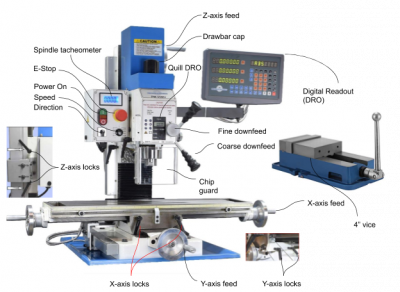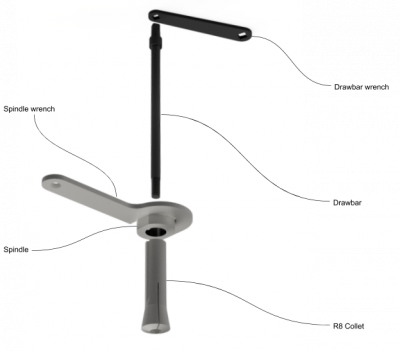Table of Contents
Manual Milling Machine Training SOP
Last edited: Furst (10/12/20)
Instructor:
Date:
| Name (Last, First) | Group or Company | Signature (First, Last) | |
|---|---|---|---|
| 1 | |||
| 2 | |||
| 3 | |||
| 4 | |||
| 5 | |||
| 6 |
Tool Location
Innovation Workshop, Elings 2448
Overview:
PM-25MV Mill
- A 3-axis mill with R8 spindle. Spindle speeds varies continuously from 50-2500 rpm.
- Weight: 275 lbs
- Spindle motor: Brushless DC 750 W (1 HP)
- Travel
- X-axis: 20.5”
- Y-axis: 7”
- Z-axis: 13”
- Axis locks
- Quill lock
- 4” Vice
- Hold downs for vice
- Indicating vice
- DRO
- One for table and headstock. A separate DRO for quill.
- Functions
- Zeroing
- Inputting coordinate
- Metric/inch interchange
- Absolute/incremental coordinates
- Automatic half
- Calculator
- Entering tool offset
Training
Safety Hazards
- This machine is designed for milling and drilling operations by experienced users familiar with metal-working hazards.
- Wear ANSI-approved full-face or eye protection at all times when using the machine (everyday eyeglasses are not reliable protection against flying particles).
- Wear proper apparel and non-slip footwear – be sure to prevent hair, clothing or jewelry from becoming entangled in moving parts. Gloves – including tight-fitting disposables can be hazardous!
- Be sure the work area is properly lit.
- Never leave chuck keys, wrenches or other loose tools on the machine.
- Be sure the work piece and machine ways are secure before commencing milling or drilling hold-downs and/or vise fully tightened, X-Y-Z axes locked, cutting tool secured
- Use moderation: light cuts, low spindle speeds and slow table motion give better, safer results than “hogging”.
- Don’t try to stop a moving spindle by hand – allow it to stop on its own.
- Disconnect 110V power from the mill before maintenance operations such as oiling or adjustments
- Maintain the machine with care – check lubrication and adjustments daily before use.
- Clean the machine routinely – remove chips by brush or vacuum, not compressed air (which can force debris into the ways).
Setup
- Turn on the mill
- Turn on DRO by flipping switch on back
- Turn on Quill DRO by pressing power button
- Once part and tool are secure, spindle may be turned on by pressing the green power button on the speed controller panel
- Setting up a vice
- Adjust the Y-axis to pre-load the indicator to mid range at the tightly-clamped side of the vise, then lock the Y-axis. Do not allow the spindle to rotate during this procedure.
- Note the indicator reading, then watch the indicator as you traverse the table slowly toward the loosely clamped side. (Also watch for any sign of spindle rotation.) Ideally, there should be no discrepancy between the indicator readings at the two ends — unlikely at the first attempt. Return the table to the starting point, then repeat the process, tapping the vise in as you go. Repeat the process as often as necessary for the desired accuracy, progressively tightening the “looser” nut. Now fully tighten both nuts, and re-check again (tightening a nut can itself introduce significant error).
Change Tooling
- Remove Tooling
- Lock the spindle with the C-wrench, loosen the drawbar one half turn or less, just enough to unseat the taper, then tap the top of the drawbar with a soft hammer to release the R-8 device. Unscrew the drawbar with one hand while supporting the R-8 device with the other hand.
Install Tooling
- Install the R-8 device, then hand-thread the drawbar into it until the shoulder on the drawbar bottoms on the splined spindle, diagram above (on the machine this is concealed by the drawbar cap, Figure 3-2). Lock the spindle with the special C-wrench, page 5, while at the same fully tightening the drawbar with an 8 mm wrench.
Securing the part
- Vice
- Position part in vice. Vice maximum length is 4”. Use parallels if needed. Press firmly down on part to ensure it is properly seated.
- Tighten vice
- Hold-downs
- Hold downs can be accessed in the “Milling Supplies Drawer” (See Supplies).
Moving the Table
- Conventionally, left-right movement of the table is said to be along the X-axis (also called “longitudinal travel” or “traversing”). Front-back movement is on the Y-axis, sometimes called “cross travel”.
- Each axis has a leadscrew with handwheel and graduated dial with 0.001” divisions, 0.1” per revolution.
- The position of the table is indicated by the digital readout (DRO)
- Leadscrew backlash
Moving headstock
- For milling
- Z-axis crank. When the headstock is in the desired place, lock it in place.
- Changing the speed
- Adjust the speed knob one the headstock while the machine is on
-
- For drilling operations, loosen knob (4), allowing the lever hub to rotate independently of sleeve (3).
- In the drilling mode, coarse feed, the mill operates like a standard drill press with a 3-lever hub; lever action lowers or raises the quill in the usual way by rack and pinion. Return action is assisted by a compression spring within the quill and spindle assembly.
- For fine downfeed
- For milling operations calling for precise, repeatable control of tool depth, tighten knob (4) to engage hub (1) with the internal taper on sleeve (3). Tighten the Z-axis locks, Figure 3-6.
- Quill DRO indicates quill position
Using DRO
- Seroing
- Move the table to the desired position. Zero an axis by pressing X0, y0, or Z0.
- inputting coordinate
- Press X, Y, or Z
- Enter the position using the keypad
- Press ENT
- Metric/inch interchange
- Press MM/INCH
- Absolute/incremental coordinates
- There are two sets of basic coordinates display, ABS (absolute) and INC (incremental) displays.
- Toggle by pressing ABS/INC
- Automatic half function
- Touch one side of the workpiece with the tool. Zero the axis.
- Touch the tool to the other side of the workpiece.
- Press X or Y, then press 1/2
- Calculator
- Calculations can be done once the calculator button is pressed.
- Edgefinding
- Load edge finder in the spindle.
- Turn RPM to 1300.
- Lower the quill so that the edge finder probe can collide with the edge whose position you want to measure.
- Move the table so that the probe touches the edge of the part, causing the probe to become offset with the shank. At this point, the edge has been found.
- Raise the quill. Offset the table position by half the edge finder diameter. Zero the axis.
- Zeroing Z
- Find a dowel pin (See Supplies). Lower the tool so it is slightly above the dowel pin
- Slide the dowel pin under the tool, gradually lower the Z-axis until the dowel pin rubs the bottom of the tool but can still pass through underneath.
- Remove the dowel pin. Raise the table by the diameter of the dowel pin.
- Drilling
- Look up proper RPM for tool and material
- locate XY position, use quill to downfeed
- Center drill followed by peck drilling the hole
- Peck drilling
- periodically remove drill from hole to clear chips
- Milling
- Consult resources for appropriate tool RPM and feed speed.
- Fully retract the quill and lock it with the lever on the left of the headstock
- Facing
- Side cutting
- Tapping
- Do not turn the spindle motor on during tapping
- Place the tap guide in the spindle
- Position hole under the tap
- Apply tapping fluid
- Turn the tap clockwise to cut threads. Periodically reverse tap direction to clear out chip build up.
Maintenance
- Tramming the headstock
- Oiling
- Clearing Chips
Supplies
- Tooling
- End mills
- Drills
- Center punches
- Hold downs
- Indicator
- Used for tramming in the vice
- Aligning parts held with hold downs
- Dowel pins
- Used for zeroing Z-axis
- Collets
- Fractional
- up to 9/16“
- R8 Precision Drill chuck
- 0-0.5”
- Wrenches
- 14 mm for vice
- 10 mm for drawbar
- Tapmagic cutting fluid
- Used for tapping
- 3-In-One multi purpose oil
- Used for drilling and milling
Mill SOP Quick Review
Tool Lead:
Contact: andrewfurst@ucsb.edu
Safety Concern
- Untrained or unsupervised operators risk serious injury.
- Risk of metal splinters and burns from flying chips. Wear safety goggles, closed-toe shoes, long pants.
- Keep body parts clear of spindle and workpiece while machine is moving
- Take care when handling heavy objects
- Make sure the part and tool are secured before starting a machining operation
- Remove chuck keys and other tools before starting the machine
Safe Operation Procedures Review
- Install a collet or drill chuck
- Select the corresponding size tool holder for the diameter of the tool shank
- Align the key in the spindle with the key in the tool holder by spinning the tool holder while maintaining light upward pressure into the spindle
- If tool holder is a drill chuck tighten the drawbar with the wrench on the drawbar and large open ended wrench around the spindle flats
- If tool holder is a collet, turn the drawbar to retain the tool holder, install the tool shank into the collet, and then tighten the drawbar the remining distance using a wrench on the drawbar and the large open ended wrench on the spindle flats
- Be sure to remove all wrenches and drill chuck keys before powering on the machine
- Zeroing the machine
- Use an edge finder in the spindle at approximately 1000 RPM to set the part zero. Be sure to account for the radius of the edge finder and cutting tool you intend to be using
- With the tool in the spindle, Z zero can be set by rolling a dowel pin over the workpiece under the tip of the tool while slowly dialing down the Z axis until the dowel pin catches the tool. Be sure to account for the diameter of the dowel pin
- Milling and drilling
- Refer to the feeds and speeds chart and select the correct spindle RPM based on on tool diameter, tool material, and workpiece material.
- Use DRO to set the correct depth of feed for the tool and workpiece material
- Use the hand crank so take smooth consistent cuts, be sure to avoid sudden movements when moving the machine and take passes appropriate to the rigidity of the machine (not very ridged).
Post Processing
- Deburr part using a file or deburring tool
- Vacuum the mill and table
- Remove tool and tool holder from machine
- Wipe the clamping surface of the vice with a towel
Maintenance
- Periodically insure the vice is square to the table using a dial indicator and sweeping back and forth against the fixed jaw
- Periodically oil the machine to prevent corrosion, wear, and binding of axes
- After machine is moved or is crashed, insure head remains square to the table by securing a dial indicator in the spindle and indicating the table by rotating the spindle by hand. Indicator should show no consistent pattern



